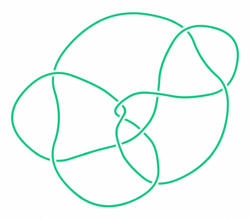| Perko pair | |
|---|---|
| Arf invariant | 1 |
| Braid length | 10 |
| Braid no. | 3 |
| Bridge no. | 3 |
| Crosscap no. | 2 |
| Crossing no. | 10 |
| Genus | 3 |
| Hyperbolic volume | 5.63877 |
| Unknotting no. | 3 |
| Conway notation | [3:-20:-20] |
| A–B notation | 10161/10162 |
| Dowker notation | 4, 12, -16, 14, -18, 2, 8, -20, -10, -6 |
| Last / Next | 10160 / 10162 |
| Other | |
| hyperbolic, fibered, prime, reversible | |
In the mathematical theory of knots, the Perko pair, named after Kenneth Perko, is a pair of entries in classical knot tables that actually represent the same knot. In Dale Rolfsen's knot table, this supposed pair of distinct knots is labeled 10161 and 10162. In 1973, while working to complete the classification by knot type of the Tait–Little knot tables of knots up to 10 crossings (dating from the late 19th century),[1] Perko found the duplication in Charles Newton Little's table.[2] This duplication had been missed by John Horton Conway several years before in his knot table and subsequently found its way into Rolfsen's table.[3] The Perko pair gives a counterexample to a "theorem" claimed by Little in 1900 that the writhe of a reduced diagram of a knot is an invariant (see Tait conjectures), as the two diagrams for the pair have different writhes.
In some later knot tables, the knots have been renumbered slightly (knots 10163 to 10166 are renumbered as 10162 to 10165) so that knots 10161 and 10162 are different. Some authors have mistaken these two renumbered knots for the Perko pair and claimed incorrectly that they are the same.[4]
- The Perko pair
-
10161
-
10162 (in Rolfsen's original numbering)
The Perko pair was correctly illustrated and explained on the first page of the Science section of the July 8, 1986 New York Times.
- ^ Charles Newton Little, Non-alternating +/- knots, Trans. Roy. Soc. Edinburgh 39 (1900), page 774.
- ^ Kenneth A. Perko Jr.(b.1943), On the classification of knots. Proc. Amer. Math. Soc. 45 (1974), 262—266.
- ^ Dale Rolfsen, Knots and Links (see Appendix C for the knot table), 1976, ISBN 0-914098-16-0.
- ^ "The Revenge of the Perko Pair", RichardElwes.co.uk. Accessed February 2016. Richard Elwes points out a common mistake in describing the Perko pair.

